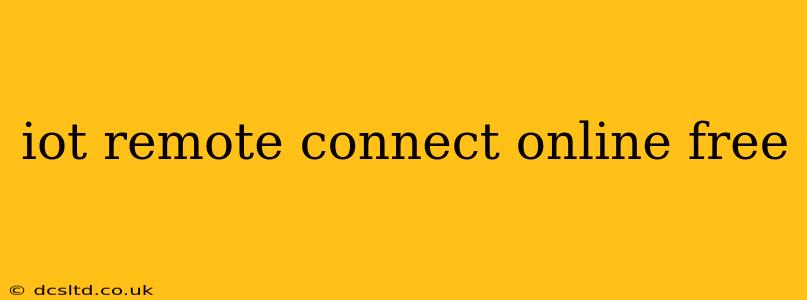The Internet of Things (IoT) connects everyday devices to the internet, enabling remote monitoring and control. Many people seek free options for remote access to their IoT devices, but understanding the limitations and security implications is crucial. This guide explores free IoT remote connection methods, highlighting their advantages and disadvantages to help you make an informed decision.
What are the Best Free IoT Remote Connection Methods?
Several methods offer free remote access to IoT devices, each with its own strengths and weaknesses. These often involve using a combination of hardware and software, which we will explore below.
1. Using a Public Cloud Platform's Free Tier: Many cloud platforms like AWS, Google Cloud, and Azure offer free tiers for limited usage. You can leverage these tiers to host your IoT device's data and control logic. This allows you to access your device remotely through a web interface or mobile app. However, free tiers typically have limitations on storage, compute power, and data transfer. Once you exceed these limits, you'll likely need to upgrade to a paid plan.
2. Self-Hosting on a Personal Server: For technically proficient users, self-hosting a server at home (or using a VPS with a generous free trial) can be a cost-effective solution. This involves configuring a server to act as a gateway for your IoT devices. You'll need to manage the server's security and maintenance yourself. This approach requires significant technical expertise and isn't recommended for beginners due to potential security vulnerabilities.
3. Utilizing Open-Source Projects: Many open-source projects provide software and tools for building remote IoT connections. These projects often have active communities offering support and guidance. However, relying on open-source solutions requires technical expertise to set up, configure, and maintain the system. Security is also your responsibility, demanding careful configuration to mitigate risks.
How Secure are Free IoT Remote Connection Methods?
Security is a paramount concern when connecting IoT devices remotely. Free methods often compromise on security features found in commercial solutions.
Vulnerabilities: Free options frequently lack robust authentication, authorization, and encryption mechanisms. This makes them vulnerable to attacks, potentially exposing your data and control over your devices.
Mitigation Strategies: While completely eliminating risks is difficult with free options, you can mitigate them by:
- Strong Passwords: Use long, complex, and unique passwords for all access points.
- Two-Factor Authentication (2FA): Implement 2FA whenever possible to add an extra layer of security.
- Regular Software Updates: Keep your software and firmware updated to patch security vulnerabilities.
- Firewall: Configure a firewall to restrict access to your IoT devices.
What are the Limitations of Free IoT Remote Connection Methods?
Free methods inherently have limitations:
- Scalability: Free options often lack the scalability needed for large-scale deployments.
- Support: Expect limited or no official support for free solutions.
- Features: Free options often lack advanced features such as detailed analytics, sophisticated security mechanisms, or robust monitoring tools.
- Bandwidth Limits: Free cloud tiers often impose strict limitations on data transfer, making them unsuitable for devices generating large amounts of data.
How Can I Choose the Right Free IoT Remote Connection Method?
The best method depends on your technical skills, the number of devices you're connecting, and your security requirements.
- Beginners: Consider leveraging a reputable cloud platform's free tier. It’s the easiest option, albeit with usage limitations.
- Tech-Savvy Users: Self-hosting or using open-source projects may be feasible, but requires significant technical expertise and responsibility for security.
Always prioritize security and carefully weigh the risks involved before connecting your IoT devices remotely.
What are the Alternatives to Free IoT Remote Connection?
If security and scalability are paramount, commercial IoT platforms provide robust solutions with advanced features, reliable support, and better security. While they come at a cost, these services offer peace of mind and ensure your data and devices are better protected.
This comprehensive guide provides a balanced perspective on free IoT remote connection methods, encouraging informed decision-making while emphasizing the importance of security and its trade-offs. Remember, the "free" price often comes with compromises that may not be acceptable for every user or application.
